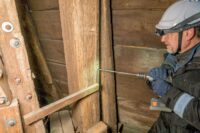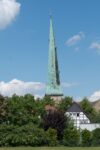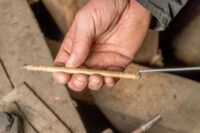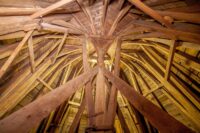 Core samples have determined the exact age of the spire of the St. Johannes Baptist church in Delbrück, East Westphalia, for the first time. Dendrochronological analysis of wood samples taken from the spire found they were felled in the winter of 1479/1480, which means the spire was built in 1480.
Core samples have determined the exact age of the spire of the St. Johannes Baptist church in Delbrück, East Westphalia, for the first time. Dendrochronological analysis of wood samples taken from the spire found they were felled in the winter of 1479/1480, which means the spire was built in 1480.
Frank Högg, a building researcher of the Westphalia-Lippe Regional Association (LWL), drilled thin cores out of the oak beams in the interior of the spire. It’s that same oak that gives the spire its moniker: “leaning tower of Delbrück.” Its characteristic tilt that defines the city skyline is caused by the wood frame construction warping over time and exposure to the weather.
 “The elaborate construction of this octagonal pointed helmet is an impressive example of medieval craftsmanship,” explains Högg. The imperial stem, which extends from the base of the roof to the top, consists of four timbers mortised together and has a total length of over 30 meters. “The construction of the rafters and struts follows the tradition of Westphalian carpentry and represents a constructive masterpiece,” says Högg.
“The elaborate construction of this octagonal pointed helmet is an impressive example of medieval craftsmanship,” explains Högg. The imperial stem, which extends from the base of the roof to the top, consists of four timbers mortised together and has a total length of over 30 meters. “The construction of the rafters and struts follows the tradition of Westphalian carpentry and represents a constructive masterpiece,” says Högg.
 St. Johannes Baptist is a Catholic parish church in the Paderborn district of Delbrück. There were several iterations of the building, with the earliest surviving sections — the central nave and lower part of the tower — built around 1180. The southern aisle of the old Romanesque three-aisled basilica was replaced with a much larger Gothic nave and choir in around 1340. Neogothic elements were added to the north side in the 1860s.
St. Johannes Baptist is a Catholic parish church in the Paderborn district of Delbrück. There were several iterations of the building, with the earliest surviving sections — the central nave and lower part of the tower — built around 1180. The southern aisle of the old Romanesque three-aisled basilica was replaced with a much larger Gothic nave and choir in around 1340. Neogothic elements were added to the north side in the 1860s.
 Little is known about the pre-modern architectural history of the church as there have been no archaeological investigations and there are no surviving records. The approximate dates of construction come from stylistic comparisons with other churches. Up until now, the spire was thought to have been built around 1400.
Little is known about the pre-modern architectural history of the church as there have been no archaeological investigations and there are no surviving records. The approximate dates of construction come from stylistic comparisons with other churches. Up until now, the spire was thought to have been built around 1400.
* This article was originally published here

“The elaborate construction of this octagonal pointed helmet is an impressive example of medieval craftsmanship,” explains Högg. The imperial stem, which extends from the base of the roof to the top, consists of four timbers mortised together and has a total length of over 30 meters. “The construction of the rafters and struts follows the tradition of Westphalian carpentry and represents a constructive masterpiece,” says Högg.









No comments:
Post a Comment